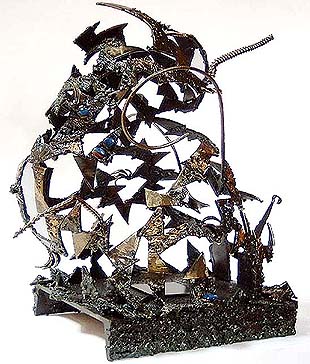| |
_a1.jpg)
THE SEA PINNACLE SERIES
-> View Introduction (QickTime Video)
The inspiration for the Sea Pinnacle Series comes from a dive off the Father Islands in Papua New Guinea. These uninhabited islands are extremely remote; it takes a boat two days to reach them from Rabul. In the surrounding waters, huge pinnacles come up from a depth of 6000 feet below sea level to within five to ten feet of the ocean's surface. The swirling activity around one of these dive sites is amazing. Schools of fish dart in and out; streams of living color shoot from the coral formations; and the giant corals harbor thousands of exquisite animals and plants, concealing them from deep-water predators.
Immediately after my first dive on one of these pinnacles, I obtained some paper from the boat captain to sketch out the basic ideas for this series, which I began in 2001. I'm still creating new versions, using a new technique I developed by partially melting the steel with a cutting torch, so that it reacts as if it were an eruption from a live volcano. Most non- fringing reefs were originally formed by volcanic eruptions.
The pinnacles are made primarily of steel, and range in height from 20 inches to 40 inches. The early pinnacles in this series are darker and denser to give the feeling of the awesome size and power of this natural phenomenon. These were completed in 2001 and the early part of 2002. The most recent versions of the sea pinnacles, which are shown on this website, are more open and abstract. Generally, this series has a base that is either square or triangular and approximately 12" by 12". As the Pinnacle Series evolved, the open spaces became more important; so did the diversity of textures among the steel components. Some are very shiny, others are very dark and others have been textured to resemble the cooled lava (pumice) of the giant pinnacles.
Leslie's Pinnacle was the actual name of the first pinnacle that I saw. When I first encountered these pinnacles in the sea off the coast of New Guines, I was awestruck at their power and beauty. Coincidentaly, this pinnacle had the same name as my significant other who was my dive buddy on this trip. It was the first one of this series.
Leslie's Pinnacle II is another version and the third one of this series. It was also completed in 2001 and all of Leslie's Pinnacles are approximately 30" high on 12" by 12" bases, and weigh approximately 40 lbs. Another version of Leslie Pinnacles is currently on exhibit at Fine Arts Gallery of Bronxville. Anther of the Pinnacles is on display at www.biddingtons.com.
Wildebeest evolved after the fifth pinnacle. From here on, each pinnacle started to take on a totally different life of its own as it was being created. During its creation I visualized some African masks that were patterned after this fabled African animal. Wildebeest is meant to guard over my house so that anyone who comes in is protected from the evil spirits. This sculpture is more open than the prior sculptures of this series. Wildebeest is primarily steel with bronze accents. It is on a triangular base with a width of 10", a length of 12" and is approximately 20 in. high. It weighs approximately 20 lbs.
Medieval Warrior evolved in much the same way. Its subject seems to me both benevolent and dangerous.
Each sea pinnacle that I saw on my subsequent dives had its own unique shape and characteristics. Both Medieval Warrior and Wildebeest have elements that move. First, these elements signify that life and the relationships of the reef's inhabitants are always changing. Second, because the inspirations for this series are such powerful and massive wonders of nature, I wanted each to have a playful element so that people would understand that what initially looks massive and foreboding is full of beautiful colors and wonderful small fish and live coral. Medieval Warrior is primarily steel, with bronze accents. It is on a 12" by 12" base and is approximately 32" high. It weighs approximately 40 lbs. A small floodlight can be inserted on top of the base; when the light is turned on, elements of the sculpture are projected onto the ceiling.
Big Mumsa is by far the largest of this series and was completed in 2003. Other people at Pratt were encouraging me to make much larger versions of this series. Not only does Big Mumsa incorporate all the elements of Medieval Warrior, it does so on a much larger scale and looks totally different. Small bits of colored glass, representing fragile coral, are incorporated. Big Mumsa is on a 16" by 14" base, is about 32" high and weighs over 50lbs. My 21/2 year old grandson likes Big Mumsa the best because it makes him laugh and he loves to play with the components that move. When lit up at night it makes the ceiling look like a ballet.

|
|
|
|
_a1.jpg)